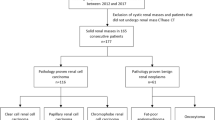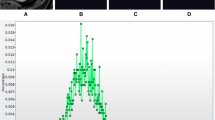Abstract
Purpose
To assess CT texture features of small renal cell carcinomas (≤ 4cm) for association with key pathologic features including protein biomarkers.
Methods
Quantitative CT texture analysis (CTTA) of small renal cancers (≤ 4cm) was performed on non-contrast and portal venous phase abdominal MDCT scans with an ROI drawn at the largest cross-sectional diameter of the tumor using commercially available software. Texture parameters including mean pixel attenuation, the standard deviation (SD) of the pixel distribution histogram, entropy, the mean of positive pixels, the skewness (i.e., asymmetry) of the pixel histogram, kurtosis (i.e., peakness) of the pixel histogram, and the percentage of positive pixels were correlated with pathologic data from surgical resection, including histology and nuclear grade, as well as microarray analysis in a subset (n = 40) including Ki67 index, CRP, and neovascularization (CD105/CD31).
Results
Portal venous phase images were available in 249 patients (105 women, 144 men; mean age, 56.7 years) with tumors ≤ 4cm (mean, median, range, ± SD; 2.66, 2.60, 0.3–4.0 ± 0.85 cm). CT texture features of standard deviation, mean of the positive pixels, and entropy of the pixel histogram were significantly associated with histologic cell type (clear vs. non-clear; p < 0.001). Entropy and mean of the positive pixels also showed an association with nuclear grade, although not statistically significant. In the microarray analysis subset, kurtosis of the pixel histogram was associated with CD105/CD31 (p = 0.05). SD also showed some association with CD 105 positivity (p = 0.02) and CAIX expression (p = 0.01). Non-contrast CT images were available in 174 patients (72 women, 102 men; mean age, 57.5 years). Although the association with histology was not as strong as on the portal venous phase, in the subset of patients with microarray data, SD was found to correlate with CRP (p = 0.08), kurtosis with CRP (p = 0.004), CD105/CD31 (p = 0.002), and with Ki 67 index (p < 0.001).
Conclusion
CT texture features were significantly associated with important histopathologic features in small renal cancers. These non-invasive measures can be performed retrospectively and may provide useful information when determining follow-up and treatment of small renal cancers.




Similar content being viewed by others
References
Frank I, et al. (2003) Solid renal tumors: an analysis of pathological features related to tumor size. J Urol 170(6 Pt 1):2217–2220
Klatte T, et al. (2008) Tumor size does not predict risk of metastatic disease or prognosis of small renal cell carcinomas. J Urol 179(5):1719–1726
Pahernik S, et al. (2007) Small renal tumors: correlation of clinical and pathological features with tumor size. J Urol 178(2):414–417 ((discussion 416-7))
Young JR, et al. (2013) Clear cell renal cell carcinoma: discrimination from other renal cell carcinoma subtypes and oncocytoma at multiphasic multidetector CT. Radiology 267(2):444–453
Raman SP, et al. (2013) Chromophobe renal cell carcinoma: multiphase MDCT enhancement patterns and morphologic features. AJR Am J Roentgenol 201(6):1268–1276
Pierorazio PM, et al. (2013) Multiphasic enhancement patterns of small renal masses (</=4 cm) on preoperative computed tomography: utility for distinguishing subtypes of renal cell carcinoma, angiomyolipoma, and oncocytoma. Urology 81(6):1265–1271
Karlo CA, et al. (2014) Radiogenomics of clear cell renal cell carcinoma: associations between CT imaging features and mutations. Radiology 270(2):464–471
Egbert ND, et al. (2013) Differentiation of papillary renal cell carcinoma subtypes on CT and MRI. AJR Am J Roentgenol 201(2):347–355
Choi YA, et al. (2014) Subtype differentiation of renal cell carcinoma using diffusion-weighted and blood oxygenation level-dependent MRI. AJR Am J Roentgenol 203(1):W78–W84
Takeuchi M, et al. (2015) MRI for differentiation of renal cell carcinoma with sarcomatoid component from other renal tumor types. Abdom Imaging 40(1):112–119
Wang W, et al. (2014) Magnetic resonance imaging and computed tomography characteristics of renal cell carcinoma associated with Xp11.2 translocation/TFE3 gene fusion. PLoS ONE 9(6):e99990
Ganeshan B, Miles KA (2013) Quantifying tumour heterogeneity with CT. Cancer Imaging 13:140–149
Lubner MG, et al. (2017) CT texture analysis: definitions, applications, biologic correlates, and challenges. Radiographics 37(5):1483–1503
Ganeshan B, et al. (2012) Tumour heterogeneity in non-small cell lung carcinoma assessed by CT texture analysis: a potential marker of survival. Eur Radiol 22(4):796–802
Zhang H, et al. (2013) Locally advanced squamous cell carcinoma of the head and neck: CT texture and histogram analysis allow independent prediction of overall survival in patients treated with induction chemotherapy. Radiology 269(3):801–809
Yip C, et al. (2014) Primary esophageal cancer: heterogeneity as potential prognostic biomarker in patients treated with definitive chemotherapy and radiation therapy. Radiology 270(1):141–148
Ng F, et al. (2013) Assessment of primary colorectal cancer heterogeneity by using whole-tumor texture analysis: contrast-enhanced CT texture as a biomarker of 5-year survival. Radiology 266(1):177–184
Miles KA, et al. (2014) Multifunctional imaging signature for V-KI-RAS2 Kirsten rat sarcoma viral oncogene homolog (KRAS) mutations in colorectal cancer. J Nucl Med 55(3):386–391
Gandaglia G, et al. (2014) Contemporary incidence and mortality rates of kidney cancer in the United States. Can Urol Assoc J 8(7–8):247–252
Moreno CC, et al. (2016) Changing abdominal imaging utilization patterns: perspectives from medicare beneficiaries over two decades. J Am Coll Radiol 13(8):894–903
Raman SP, et al. (2014) CT texture analysis of renal masses: pilot study using random forest classification for prediction of pathology. Acad Radiol 21(12):1587–1596
Goh V, et al. (2011) Assessment of response to tyrosine kinase inhibitors in metastatic renal cell cancer: CT texture as a predictive biomarker. Radiology 261(1):165–171
Lubner MG, et al. (2016) CT textural analysis of large primary renal cell carcinomas: pretreatment tumor heterogeneity correlates with histologic findings and clinical outcomes. AJR Am J Roentgenol 207(1):96–105
Abel EJ, et al. (2014) Analysis and validation of tissue biomarkers for renal cell carcinoma using automated high-throughput evaluation of protein expression. Hum Pathol 45(5):1092–1099
Miles KA, et al. (2009) Colorectal cancer: texture analysis of portal phase hepatic CT images as a potential marker of survival. Radiology 250(2):444–452
Ganeshan B, et al. (2010) Texture analysis of non-small cell lung cancer on unenhanced computed tomography: initial evidence for a relationship with tumour glucose metabolism and stage. Cancer Imaging 10:137–143
Miles KA, Ganeshan B, Hayball MP (2013) CT texture analysis using the filtration-histogram method: what do the measurements mean? Cancer Imaging 13(3):400–406
Chow WH, et al. (1999) Rising incidence of renal cell cancer in the United States. JAMA 281(17):1628–1631
Stafford HS, et al. (2008) Racial/ethnic and gender disparities in renal cell carcinoma incidence and survival. J Urol 179(5):1704–1708
Nguyen MM, Gill IS, Ellison LM (2006) The evolving presentation of renal carcinoma in the United States: trends from the Surveillance, Epidemiology, and End Results program. J Urol 176(6 Pt 1):2397–2400 ((discussion 2400))
Ng F, et al. (2013) Assessment of tumor heterogeneity by CT texture analysis: can the largest cross-sectional area be used as an alternative to whole tumor analysis? Eur J Radiol 82(2):342–348
Nelson DA, et al. (2004) Hypoxia and defective apoptosis drive genomic instability and tumorigenesis. Genes Dev 18(17):2095–2107
Hodgdon T, et al. (2015) Can quantitative CT texture analysis be used to differentiate fat-poor renal angiomyolipoma from renal cell carcinoma on unenhanced CT images? Radiology 276(3):787–796
Ganeshan B, et al. (2013) Non-small cell lung cancer: histopathologic correlates for texture parameters at CT. Radiology 266(1):326–336
Eichelberg C, et al. (2009) Diagnostic and prognostic molecular markers for renal cell carcinoma: a critical appraisal of the current state of research and clinical applicability. Eur Urol 55(4):851–863
Wiesener MS, et al. (2001) Constitutive activation of hypoxia-inducible genes related to overexpression of hypoxia-inducible factor-1alpha in clear cell renal carcinomas. Cancer Res 61(13):5215–5222
Lidgren A, et al. (2005) The expression of hypoxia-inducible factor 1alpha is a favorable independent prognostic factor in renal cell carcinoma. Clin Cancer Res 11(3):1129–1135
Lidgren A, et al. (2006) Hypoxia-inducible factor 1alpha expression in renal cell carcinoma analyzed by tissue microarray. Eur Urol 50(6):1272–1277
Visapaa H, et al. (2003) Correlation of Ki-67 and gelsolin expression to clinical outcome in renal clear cell carcinoma. Urology 61(4):845–850
Gayed BA, et al. (2014) Ki67 is an independent predictor of oncological outcomes in patients with localized clear-cell renal cell carcinoma. BJU Int 113(4):668–673
Sandlund J, et al. (2006) Endoglin (CD105) expression in human renal cell carcinoma. BJU Int 97(4):706–710
Saroufim A, et al. (2014) Tumoral CD105 is a novel independent prognostic marker for prognosis in clear-cell renal cell carcinoma. Br J Cancer 110(7):1778–1784
Bauman TM, et al. (2016) Neovascularity as a prognostic marker in renal cell carcinoma. Hum Pathol 57:98–105
Sejima T, Miyagawa I (1999) Expression of bcl-2, p53 oncoprotein, and proliferating cell nuclear antigen in renal cell carcinoma. Eur Urol 35(3):242–248
Lubner MG, et al. (2015) CT textural analysis of hepatic metastatic colorectal cancer: pre-treatment tumor heterogeneity correlates with pathology and clinical outcomes. Abdom Imaging 40(7):2331–2337
Author information
Authors and Affiliations
Corresponding author
Ethics declarations
Funding
Funding support was provided by University of Wisconsin School of Medicine and Public Health Shapiro program and Department of Radiology Research and Development.
Disclosures
MGL: Grant funding Philips, Ethicon. PJP: co-founder of VirtuoCTC, consultant for Bracco and Check-Cap, and shareholder in SHINE, Elucent, and Cellectar Biosciences. No other disclosures from the other authors
Ethical approval
All procedures performed in studies involving human participants were in accordance with the ethical standards of the institutional and/or national research committee and with the 1964 Helsinki declaration and its later amendments or comparable ethical standards. The need for informed consent was waived.
Rights and permissions
About this article
Cite this article
Scrima, A.T., Lubner, M.G., Abel, E.J. et al. Texture analysis of small renal cell carcinomas at MDCT for predicting relevant histologic and protein biomarkers. Abdom Radiol 44, 1999–2008 (2019). https://doi.org/10.1007/s00261-018-1649-2
Published:
Issue Date:
DOI: https://doi.org/10.1007/s00261-018-1649-2




